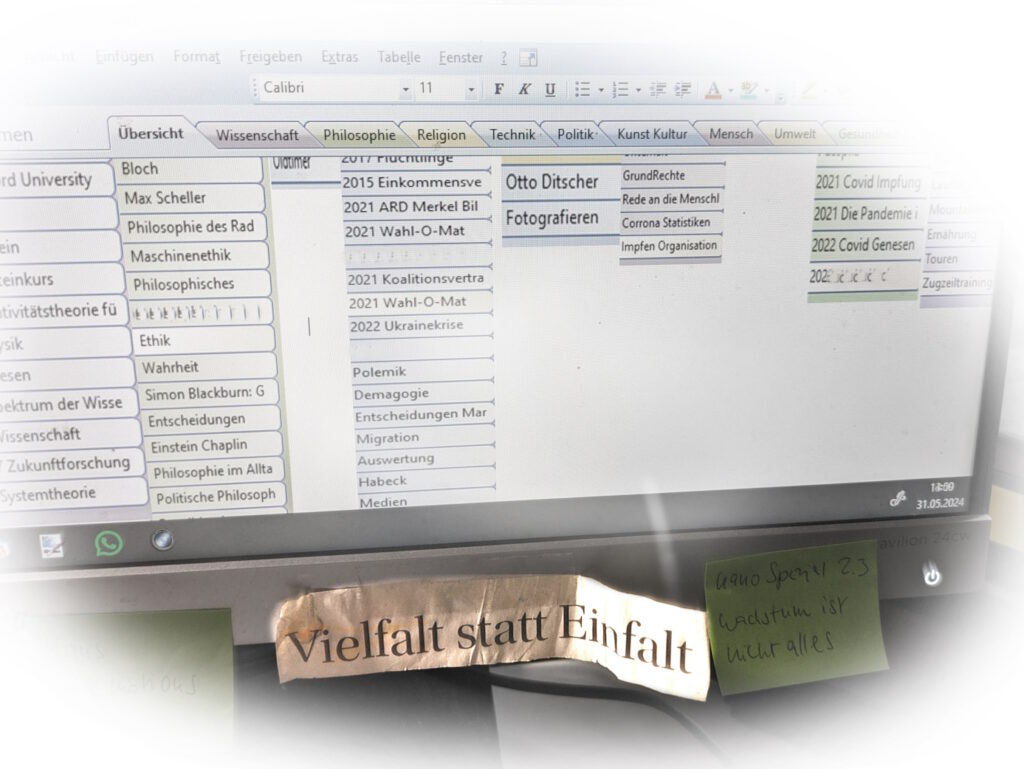Retrospective and Outlook
Outlook
3. Dec. 2024
Manfred Goschler
Capturing, organizing, and evolving different thoughts, impressions, and questions—while experimenting with content and formats—was the starting point and the motivation for creating this website. There was often no fixed goal, but rather the thrill of tackling technical and conceptual challenges independently, even without being an expert.

The self-chosen name of the website encourages exploring topics through the lens of movement and change, adopting different perspectives, and examining complex trade-offs.

Over time, the site has evolved into a kind of diary, offering space for thought experiments, images, and short videos. Yet, much remains untapped: notes and ideas await processing and integration.
One example is an old note with the phrase “diversity over simplicity.” At first glance, this statement seems decisive—perhaps as a critique of oversimplified narratives or poor communication. However, in an increasingly complex world, even this slogan feels overly one-dimensional. more practical guiding principle might be “selective diversity”—an approach that balances diversity with pragmatism and equilibrium.

A This includes the ability to navigate contrasts (see #Dynamics of Contrasts). With such reflections, the note has fulfilled its purpose and can now be discarded.
Of course, another perspective might argue differently—such as when diversity leads to chaos. This highlights that one’s viewpoint is not always the ultimate measure. It is crucial to include other perspectives: whether individual or societally coordinated, as reflected in constitutions, or artificial, as generated by AI systems.

Interim Summary
The website has developed into a space where themes have crystallized: real and virtual explorations, thought experiments and the relationship between humans and machines. Emotional and rational aspects—seemingly opposing poles—play an equally significant role.
Below, I will expand on some of these thoughts further.
Emotion and Reason
The content of this website reflects impressions and considerations. This interplay between emotional and rational aspects not only shapes the selection of topics but also influences the development of machine intelligence and its relationship to humanity.
While the emotional level often sparks creative thought experiments, the rational level serves to structure and organize them—triggering new emotions in the process. This ambivalence will likely become even more important in the evolving relationship between humans and machines.
How might artificial intelligence be aligned with humans on both emotional and rational levels?
From Impressions to Complex Challenges
An image can evoke emotions and leave varying impressions on the viewer, whereas a text must first be read and understood. However, the moment we discuss an image—or any other object, real or virtual—a perspective emerges. This perspective may align with others or differ, creating a foundation for communication that can either lead to constructive alignment or destructive conflict.
Many problems arising from such interactions remain undefined, ambiguous, or heavily influenced by the interests, preconditions, or goals of those involved. Communication issues often exacerbate these challenges.
Truth and Deception
“Do I see a young woman or an older woman in this picture?”
The saying, “A picture is worth a thousand words,” is often true, yet even a picture can deceive. Conversely, describing a picture—or any other object—has its pitfalls: a text must be read and understood, requiring a shared understanding of language, terms, and context—conditions that are often lacking.

Terms like digitalization, artificial intelligence, or sustainability exemplify how differing interpretations can complicate discussions.
To approach the truth, all available forms of expression should be utilized. In particular, texts must be analyzed for facts, opinions, speculation, and intentions—a task that is often difficult.
Example: Person X speculates about a fact Y, which later turns out to be different. A third person confirms this speculation, which is technically correct, even if the content is inaccurate. This person now knows two facts: the actual situation and a perspective on it.

Could this have been the case for an interdisciplinary exchange between science and art between two famous representatives of their genre?
Shared Foundation: Knowledge
One of the central challenges in our society is aligning (correct?) decisions that lead to subsequent actions or changes. This revisits the earlier simplicity vs. diversity scenario: simplistic decisions versus those based on broad foundations, which carry their inherent coordination problem (e.g., in private contexts, businesses, politics, etc.).
A universal solution to this problem might best be left to philosophers or believers. However, complexity could at least be reduced by establishing a shared foundation—a common knowledge base—as is often the case in many disciplines. The key value here is truth.
This means that if a decision is based on rationality and facts and can be substantiated, it is truthful or at least close to the truth. It need not be “correct,” but it should be consistent within its context.

Computers, fundamentally, possess these qualities. A simple algorithm processes input data and produces an output. In a knowledge-based system, input expands the knowledge base, while an AI system learns.
For humans, however, this process is significantly more complex, as emotions and various other human factors shape the development of knowledge. This is the essential qualitative—and somewhat mystical—difference between humans and machines.
What is knowledge, and what can we truly know?
This question preoccupied the philosopher Immanuel Kant, whose 300th birthday is celebrated in 2024. His foundational questions remain relevant:
- What can I know?
- What should I do?
- What may I hope for?
His appeal, “Dare to think for yourself!” urges each individual to rely on their own reason.
Are these three guiding questions trivial when applied in professional contexts? Do they also hold relevance in societal areas where rationality is not the highest priority? Does this not present an opportunity for better interdisciplinary understanding?

Dynamics of Contrasts
Contrasts can spark conflict but also serve as a source of inspiration. A concept that intentionally integrates contrasts could help address challenges more effectively. A central element is framing problems or goals in ways that make solutions achievable. A clear definition of objectives is often the first step in resolving apparent contradictions.
The Problem-Solver: Human and Machine
For many, solving a problem brings satisfaction, joy, and renewed energy to tackle new challenges. Humanity has always overcome obstacles—through adaptation or technological innovation.
With AI, humanity has now created a powerful tool capable of self-improvement. This presents opportunities as well as risks, such as those posed by global power dynamics.
The central concern remains: How can we act proactively? What scenarios can we foresee, and how should we respond to them?
Can machines think, decide, and act like humans? While AI impresses with speed and precision, fundamental differences persist.
A comparison with nature illustrates this point: airplanes surpass birds in speed but cannot match their elegance. Similarly, AI may surpass humans in some areas but cannot embody all human qualities. These include emotions, consciousness, free will, creativity, ethics, spirituality, empathy, intuition, and much more—the very essence of the humananity
Conclusion and Outlook
Ambivalent relationships—here often simplified and hinted at through the interplay of emotion and reason—continue to provide motivation and space for further thought experiments on this site, situated within a natural and artificial, human-made environment.
